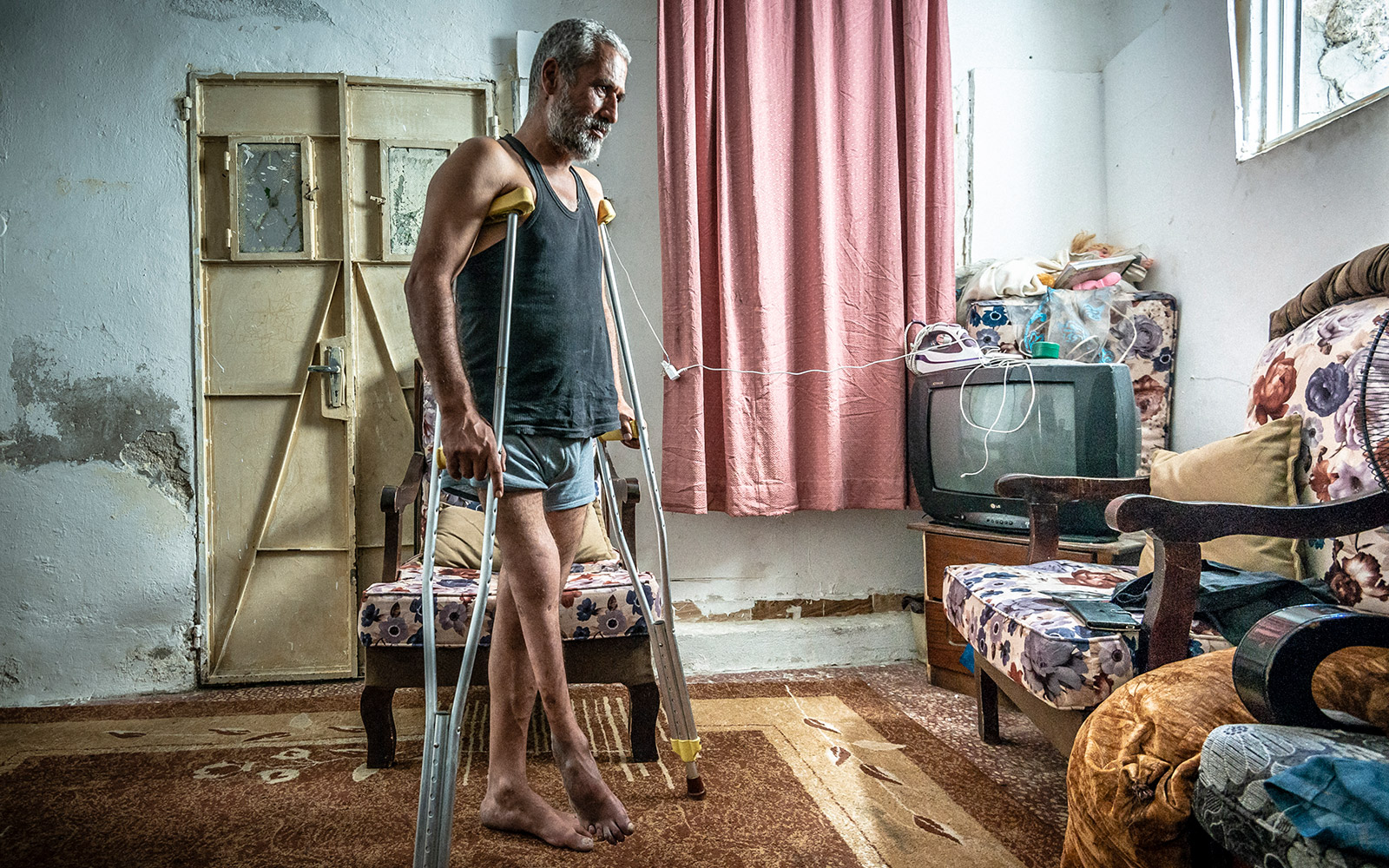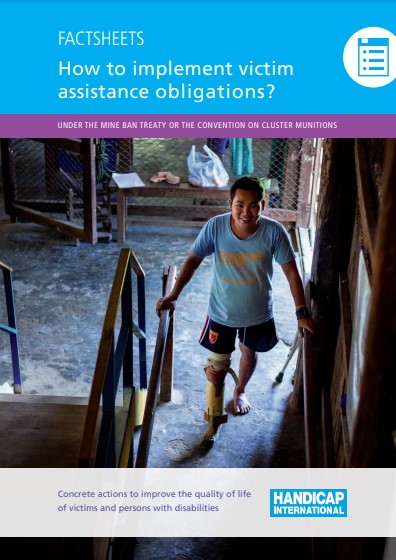



HI works on four of the five pillars of humanitarian mine action. Our work aims to be disability-inclusive, gender and conflict-sensitive, guaranteeing the participation of affected communities in project design and implementation
Today HI operates in over 60 countries, with armed violence reduction projects in 24 countries, working in extremely fragile settings such as Syria, Iraq, Yemen, Afghanistan and Libya, as well as in countries affected by legacy explosive ordnance (EO)/mine contamination such as Senegal, Colombia, Lao PDR, and Chad.
61,353
civilians were reported killed or injured by explosive weapons in 2024 according to Action on armed violence (AOAV)
72 HEURES
notre temps de réponse
opérationnelle
570,022
persons benefitting from risk education awareness-raising sessions on arms in 2023
3 984 367 m2
land released back to communities in 2023
590,643
people benefited from HI's Armed Violence Reduction actions in 2023
History
HI was created in response to the plight of victims of anti-personnel landmines and other explosive ordnance (EO) on the Thai-Cambodian border in the early 1980s. Subsequently, HI expanded its work from victim assistance to removing the threat posed by mines and other EO from the early 1990s onwards, when UNHCR faced the challenge of organizing the return of Cambodian refugees to heavily contaminated areas. HI was tasked with recruiting, training and deploying the first 90 Cambodian deminers. Over the last 30 years our interventions have expanded from victim assistance to responding to the increasing needs of people in complex environments.
HI is a co-recipient of the Nobel Peace Prize in 1997 as a founding member of the International Campaign to Ban Landmines, which led to the signing of the Anti-personnel Mine Ban Convention and has been an active member of the campaign to ban cluster munitions leading to the Convention on Cluster Munition.
Our vision
We are driven by our vision for “People to lead safer and more fulfilling lives in inclusive communities”.
Thanks to the organisation’s multiple areas of expertise, HI is best placed to positively impact people’s quality of life and socio-economic development more generally. We engage in advocacy, implement risk education, explosive ordnance disposal and victim assistance. Populations living in fragile and contaminated environments are affected by multidimensional factors. HI seeks to improve their quality of life by mobilizing a range of different in-house expertise and teams; using the right resources and savoir-faire at the right place, at the right time for the most vulnerable. In addition we capitalize on the synergies between these activities and those in the realm of weapons and ammunition risk management (WARM), and counter the impact of small arms light weapons (SALW), as well as conflict transformation. Synergies are also developed across the organization’s expertise, namely social and economic inclusion, rehabilitation, health, including mental health, protection, civil society engagement and Atlas Logistique (our operational unit filling the gap in the logistics supply chain).
We drive innovation through our use of technology, piloting drone technologies for land clearance or 3D prosthetic printing, for example, and through the processes underpinning our work: building local institutions and working with the women, men, girls and boys whose lives we aim to improve using participatory processes to ensure the interests of affected communities remain the top priority. By mainstreaming conflict sensitivity we aim to ensure that our interventions have no negative effects on local conflict dynamics but that where possible this impact is transformative.
What we do
HI is a unique organization with technical expertise in four of the five pillars of mine action: land release and clearance, risk education, victim assistance and advocacy. The fifth pillar of mine action is stockpile destruction, which is States’ responsibility.
HI deals directly with the instruments of war and their impact by:
THREAT ELIMINATION
Removing the immediate threats posed by mines and other EO through land release
BUILDING LOCAL AND STATE CAPACITIES
Building local and state capacities in land release and weapons and ammunitions risk management (WARM)
IMPROVE THE SAFETY
Improving the safety of daily activities for people living in mine/EO affected areas for whom clearance is still a long way off, through increased understanding of the threats, supporting behavioral change towards safe practices and the provision of alternative livelihood options
TECHNICAL SUPPORT
Providing technical support on risk education, land clearance, victim assistance through our participation in the International Mine Action Standards Review Board (IMAS)
VICTIM ASSISTANCE
Supporting people injured by mines/EO survivors, other persons with disabilities (PwD), and indirect victims to access services and promote their rights and participation in society
ADVOCACY
Advocating for the universalization of the Anti-personnel Mine Ban Convention (APMBC), Convention on Cluster Munitions (CCM)
CONFLICT TRANSFORMATION
Work with conflict-affected communities to transform conflicts and build more peaceful societies.
No development with armed violence and no armed violence reduction without development
The AVR response is built on the acknowledgement that the fundamental root cause of conflict is inequality, including the unequal distribution of resources. HI is very well-placed to operationalize the emergency-development nexus as we are not only an AVR actor, but also in the humanitarian, development and peace-building sectors and thus implements a continuum of services that can be deployed sequentially or in parallel.
Working on this nexus is complex and requires increased internal and external coordination – leading to joint humanitarian-development approaches, directly contributing to the realization of the Sustainable Development Goals (SDGs), up to and beyond goal 16 concerning peace and security.
Explosive Ordnance Disposal
Explosive Ordnance (EO) comprises of air delivered bombs and cluster munitions, landmines, projectiles, mortars, grenades and other explosive devices that fail to detonate as designed. In many countries those pose a significant threat to people's safety and security. They remain volatile and can kill or seriously injure people and animals if touched or moved, even long after the conflict has ended.
Explosive Ordnance Disposal (EOD) is the detection, identification, evaluation, rendering safe, recovery, and final disposal of EO. EOD enables affected populations to safely access and return to their land, homes, schools, services. Through EOD, we seek to further broaden the humanitarian and development objectives.
In line with international standards and depending on the intervention context, HI directly implements activities or supports local teams to carry out non-technical and technical surveys and clearance using different methods and tools, including manual clearance, mechanical assets, animal detection systems, innovative technologies such as drone and ground penetrating radars, and mobile data collection. The area is searched inch by inch to locate, identify and remove all hazards. The areas to be cleared are selected in consultation with the local authorities and communities. Priority is given to areas which play an important role in communities’ socio-economic development (access to hospitals, schools, markets, growing crops, building services or accessing resources – water, soil etc.).
Risk management
Explosive Ordnance Risk Education activities seek to reduce the risk of death and injury posed by weapons, mines and other Explosive Remnants of War (ERW). It involves raising awareness of all members of affected communities according to their different gender, status and exposures to the danger posed by such explosive hazards. In addition, HI promotes behavioural change via information for the general public, community-based risk education and training activities. Our actions aim to support individuals and communities to find suitable and safer alternative solutions to improve their safety and security.
Over the last decade, HI’s approach has been moving away from awareness-raising and delivering basic safety messages towards an approach based on the Humanitarian-Development nexus. In emergency contexts, HI provides awareness-raising messages by means of public information to issue clear warnings to as many people as possible.
In reconstruction, post-conflict and development contexts, HI uses community-based approaches which aim to develop local capacities to raise awareness in order to better manage the residual risk in impacted communities. Thereby, HI has developed tailored communication materials and tools, like a booklet for children or video clips on social media.
Our interventions in risk education and risk prevention activities include
PUBLIC INFORMATION
Public information through mass media
ADAPTATION TO A SPECIFIC CONTEXT
Risk education tailored to a specific context and its at-risk populations through information, education and communication tools
CONTAMINATION IMPACT SURVEYS
Contamination impact surveys to mark threats and prioritise the technical intervention according to the community’s socio-economic needs;
Weapons and Ammunition Risk Management
Weapons and Ammunition Risk Management (WARM) aims to protect communities and individuals from the impact from both unplanned explosion and weapons, and more importantly, small arms and ammunition diversion.
HI WARM interventions contribute to reducing the risk of injury and death due to unexpected explosions, thereby protecting at-risk populations especially when ammunition magazines and armouries are located in populated areas. They also help to build States’ capacities in stockpile management and securing arms and ammunition in fragile environment.
The secure management of national small arms light weapons (SALW) and ammunition stockpiles is instrumental to curbing illicit proliferation. Poor stockpile security is a prime means of diverting arms and ammunition from legal to illegal markets, and inadequate security makes theft easy. Stockpiles have the unique characteristic of needing planning and protection against both external threats and internal failings.
Our work ensures that SALW and ammunition are safe, not obsolete, not excessive and that are well managed and kept safe.
Activities include the training of personnel, ensuring safe storage by designing dedicated equipment, the rehabilitation of armouries or construction of new depots compliant with national and international standards. We also support the marking of SALW to track equipment and avoid misuse and diversion, as well as the destruction of obsolete small arms and weapons.
We work in collaboration with national authorities to support the implementation of their national strategies and action plans.
An obligation
Victim Assistance (VA) is an obligation under International Humanitarian Law (IHL), namely the Anti-Personnel Mine Ban Convention, the Convention on Conventional Weapons of War Protocol V and the Convention on Cluster Munitions.
Victims are all persons who have been killed or suffered physical or psychological injury, economic loss, social marginalization or substantial impairment of the realization of their rights caused by the use of landmines, and other EO, including cluster munitions and victim-activated Improvised Explosive Devices (IEDs). Victims include the people killed and injured by these weapons (casualties), as well as affected families and communities (indirect victims). The term ‘survivor’ is used to denote people who have had an a mine/ERW/IED accident and survived.
Our expertise
HI has been providing assistance to victims since the early 1980s.
Our expertise covers a large spectrum of the services required to advance the inclusion of victims at all levels of society. It encompasses the adequate provision of age- and gender-sensitive assistance, including physical and functional rehabilitation and psychosocial support, as well as provisions for the social and economic inclusion of victims of mine/ERW.
The implementation of VA is guided by the human rights principle of non–discrimination, which implies that access to services is determined on the basis of need and not on the basis of the cause of the injury or impairment.
Although victim assistance is a pillar of mine action, is also part of broader sectors: health, education, work & employment including social protection, and social inclusion. HI has expertise in all of these sectors.
HI’s interventions can be divided in five main areas
ACCESS TO SERVICES
Facilitating access to services by establishing a system that links people injured, survivors, other people with disabilities and the families of people killed or injured to services
DEDICATED SERVICES
Providing services for people injured, survivors, other people with disabilities and the families of people injured or killed
CAPACITY BUILDING
Capacity building of national authorities in terms of coordination and action planning on victim assistance, disability, health, education, work & employment, social inclusion, and social protection
ADVOCACY
Advocating for the universalization of the APMB and the Convention on Cluster Munitions (CCM), and the inclusion of victim assistance in the future Political Declaration on Explosive Weapons in Populated Areas (EWIPA)
RESEARCH
Applied research on victim assistance, and collective development of mine/ERW impacted communities




How to implement victim asssitance obligations?
Concrete actions to improve the quality of life of victims and persons with disabilities
Conflict Transformation
Conflict Transformation is the organizing framework for HI’s programmes which aim to build more peaceful societies. A conflict transformation approach recognizes that peace is built from within the society in conflict and proposes a change-model which constructively changes the relationships, attitudes, behaviours, interests and discourses in violence prone conflict settings, addressing the underlying structures, cultures and institutions that encourage and condition violent political and social conflict. Conflict transformation has certain principles and approaches in common with HI’s broader work on inclusion and accountable governance and reflects HI’s commitment to respecting local capacities and ownership.
HI’s conflict transformation projects have included activities to engage the most excluded members of society and “hard to reach” groups, strengthen the representation and capacities of Local Peace Committees, facilitate dialogue to identify shared interest and needs across divided communities, build trust between local communities and duty bearers, support participatory community security planning and support community thinking on harmful social norms and attitudes.
The depiction and use of boundaries, geographic names and related data shown on this map are not warranted to be error free nor do they necessarily imply official endorsement or acceptance by HI.
For more information about our projects and our approach to Armed Violence Reduction.
Dicover our team:
Photos : © B. Almeras / HI - © O. van den Broeck / HI - © N. Mazars / HI - © W. Daniels






